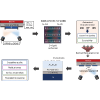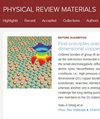Deposition of highly crystalline AlScN thin films using synchronized high-power impulse magnetron sputtering: From combinatorial screening to piezoelectric devices
IF 3.4
3区 材料科学
Q2 MATERIALS SCIENCE, MULTIDISCIPLINARY
引用次数: 0
Abstract
With the integration of 5G in day-to-day devices and the foreseeable 6G revolution, demand for advanced radio frequency (RF) microelectromechanical systems (MEMS) is growing. Aluminum scandium nitride (AlScN) has emerged as the material of choice for many of those applications due to its superior piezoelectric and electromechanical properties compared to aluminum nitride (AlN). However, synthesizing high-quality, textured AlScN thin films is challenging. Alloying of Sc in AlN induces structural frustration leading to strain, defects, disoriented grains, and disrupted crystal symmetry during growth. Higher deposition temperatures, while improving crystalline quality, risk undesirable phase precipitation and limit industrial sustainability. In addition, future MEMS technologies also demand conformal and textured coatings over diverse topographies. Addressing these challenges collectively requires new and innovative synthesis approaches. In this study, we investigate the feasibility of ionized physical vapor deposition to deposit highly oriented AlScN films with minimal defects at lower temperatures. To this end, we employ combinations of different deposition approaches, such as metal-ion synchronized (MIS) high-power impulse magnetron sputtering (HiPIMS). Leveraging the high ionization rates of HiPIMS and optimally timed substrate bias potentials, we selectively bombard the growing film with Al and/or Sc ions to enhance the adatom mobility at low temperatures while simultaneously providing the ability to tune stress and coat complex structures conformally. The nonequilibrium solubility of Sc in wurtzite AlN under different conditions is investigated using a combinatorial deposition approach. Promising candidates with Sc composition are isolated and characterized for crystallinity and residual stress. Disoriented grains, a significant issue in growing AlScN films, are observed through atomic force microscopy and found to be completely removed by substrate rotation and application of substrate biasing. The measured piezoelectric response of the films with approximately 20% Sc concentration ranges from 6.3 to 8.8 , in line with density functional theory predictions and experimentally reported values for films deposited in a production tool with coplanar geometry. At the same time, MIS-HiPIMS-deposited films offer unique properties and flexibility to tune their stress state and structural properties, thus presenting exciting opportunities for the fabrication of advanced RF filters and next-generation MEMS devices.

利用同步高功率脉冲磁控溅射沉积高结晶 AlScN 薄膜:从组合筛选到压电器件
随着 5G 技术在日常设备中的应用以及可预见的 6G 革命,对先进射频(RF)微机电系统(MEMS)的需求日益增长。与氮化铝(AlN)相比,氮化钪铝(AlScN)具有优异的压电和机电特性,因此已成为许多此类应用的首选材料。然而,合成高质量、有纹理的 AlScN 薄膜是一项挑战。AlN 中的 Sc 合金会导致结构失调,从而在生长过程中产生应变、缺陷、晶粒定向紊乱和晶体对称性破坏。较高的沉积温度虽然能提高晶体质量,但却有可能出现不理想的相沉淀,从而限制了工业的可持续发展。此外,未来的微机电系统技术还要求在不同形貌上使用保形和纹理涂层。要共同应对这些挑战,就必须采用新的创新合成方法。在本研究中,我们研究了电离物理气相沉积在较低温度下沉积具有最小缺陷的高取向 AlScN 薄膜的可行性。为此,我们采用了不同沉积方法的组合,如金属离子同步 (MIS) 高功率脉冲磁控溅射 (HiPIMS)。利用 HiPIMS 的高电离率和最佳定时的基底偏置电位,我们选择性地用 Al 和/或 Sc 离子轰击生长中的薄膜,以提高低温下的金刚原子迁移率,同时提供调整应力的能力,并对复杂结构进行保形镀膜。我们采用组合沉积方法研究了在不同条件下,Sc 在沃特兹AlN 中的非平衡溶解度。分离并表征了结晶度和残余应力。通过原子力显微镜观察到了在生长 AlScN 薄膜过程中的一个重要问题--失向晶粒,并发现通过基底旋转和施加基底偏压,可以完全消除失向晶粒。测量到的薄膜压电响应范围为 6.3 至 8.8 pm/V,与密度泛函理论的预测值以及在共面几何形状生产工具中沉积的薄膜的实验报告值一致。同时,MIS-HiPIMS 沉积的薄膜具有独特的性能和灵活性,可以调整其应力状态和结构特性,从而为制造先进的射频滤波器和下一代 MEMS 器件提供了令人兴奋的机会。
本文章由计算机程序翻译,如有差异,请以英文原文为准。
求助全文
约1分钟内获得全文
求助全文
来源期刊

Physical Review Materials
Physics and Astronomy-Physics and Astronomy (miscellaneous)
CiteScore
5.80
自引率
5.90%
发文量
611
期刊介绍:
Physical Review Materials is a new broad-scope international journal for the multidisciplinary community engaged in research on materials. It is intended to fill a gap in the family of existing Physical Review journals that publish materials research. This field has grown rapidly in recent years and is increasingly being carried out in a way that transcends conventional subject boundaries. The journal was created to provide a common publication and reference source to the expanding community of physicists, materials scientists, chemists, engineers, and researchers in related disciplines that carry out high-quality original research in materials. It will share the same commitment to the high quality expected of all APS publications.
 求助内容:
求助内容: 应助结果提醒方式:
应助结果提醒方式:


